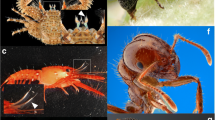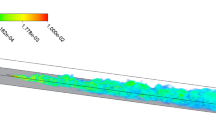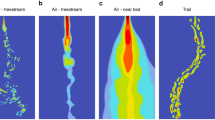Abstract
A numerical model was developed to determine advective–diffusive transport of odorant molecules to olfactory appendages of the crayfish, Procambarus clarkii. We tested the extent of molecule transport to the surfaces of aesthetasc sensilla during an antennule flick and the degree of odorant exchange during subsequent flicks. During the rapid downstroke of a flick, odorant molecules are advected between adjacent aesthetascs, while during the slower return stroke, these odorants are trapped between the sensilla and molecular diffusion occurs over a sufficient time period to transport odorants to aesthetasc surfaces. During subsequent flicks, up to 97.6 % of these odorants are replaced with new odorant molecules. The concentration of molecules captured along aesthetasc surfaces was found to increase with increased gap spacing between aesthetascs, flick speed, and distance from the proximal end of the aesthetasc, but these changes in morphology and flicking kinematics reduce the animal’s ability to take discrete samples of the odorant-laden fluid environment with each flick. Results suggest that antennule flicking allows discrete sampling of the time- and space-varying odorant signal, and high concentration odorant filaments can be distinguished from more diffuse, low concentration filaments through changes in both the timing and the encounter rate of odorant molecules to aesthetasc surfaces.














Similar content being viewed by others
References
Ache BW, Young JM (2005) Olfaction: diverse species, conserved principles. Neuron 48:417–430
Adam G, Delbrück M (1968) Structural chemistry and molecular biology. Freeman, San Francisco, pp 198–215
Atema J (1995) Chemical signals in the marine environment: dispersal, detection, and temporal signal analysis. Proc Natl Acad Sci USA 92(1):62–66
Atema J (1996) Eddy chemotaxis and odor landscapes: exploration of nature with animal sensors. Biol Bull 191:129–138
Beltz BS, Kordas K, Lee MM, Long JL, Benton JB, Sandeman DC (2003) Ecological, evolutionary and functional correlates of sensilla number and glomerular density in the olfactory system of decapod crustaceans. J Comp Neurol 455:260–269
Berg HC, Purcell EM (1977) Physics of chemoreception. Biophys J 20(2):193–219
Boeckh J, Kaissling K, Schneider D (1965) Insect olfactory receptors. Cold Spring Harb Symp Quant Biol 30:263–280
Borroni PF, Atema J (1988) Adaptation in chemoreceptor cells. J Comp Physiol A 164:67–74
Bossert WH, Wilson EO (1963) The analysis of olfactory communication among animals. J Theor Biol 5:443–469
Cheer A, Koehl M (1987) Fluid flow through filtering appendages of insects. Math Med Biol 4(3):185
Crimaldi JP, Koseff JR (2001) High-resolution measurements of the spatial and temporal scalar structure of a turbulent plume. Exp Fluids 31(1):90–102
Denny MW (1993) Air and water. Princeton University Press, Princeton
Derby CD, Steullet P, Horner AJ, Cate HS (2001) The sensory basis of feeding behaviour in the Caribbean spiny lobster, Panulirus argus. Mar Freshwater Res 52:1339–1350
DeSimone JA (1981) Physicochemical principles in taste and olfaction. In: Cagan RH, Kane MR (eds) Biochemistry of taste and olfaction. Academic Press, New York, pp 213–229
Futrelle R (1984) How molecules get to their detectors: the physics of diffusion of insect pheromones. Trends Neurosci 7(4):116–120
Getchell TV, Getchell ML (1977) Early events in vertebrate olfaction. Chem Senses 2(3):313
Gomez G, Atema J (1996a) Temporal resolution in olfaction II: time course of recovery from adaptation in lobster chemoreceptor cells. J Neurophysiol 76:1340–1343
Gomez G, Atema J (1996b) Temporal resolution in olfaction: stimulus integration time of lobster chemoreceptor cells. J Exp Biol 199:1771–1779
Gomez G, Voigt R, Atema J (1999) Temporal resolution in olfaction III: flicker fusion and concentration-dependent synchronization with stimulus pulse trains of antennular chemoreceptor cells in the American lobster. J Comp Physiol A 185:427–436
Grasso FW, Basil JA (2002) How lobsters, crayfishes, and crabs locate sources of odor: current perspectives and future directions. Curr Opin Neurobiol 12(6):721–727
Horner AJ, Schmidt M, Edwards DH, Derby CD (2008) Role of the olfactory pathway in agonistic behavior of crayfish, Procambarus clarkii. Inverteb Neurosci 8(1):11–18
Humphrey J, Mellon D (2007) Analytical and numerical investigation of the flow past the lateral antennular flagellum of the crayfish Procambarus clarkii. J Exp Biol 210(Pt 17):2969
Jackson JL, Webster DR, Rahman S, Weissburg MJ (2007) Bed-roughness effects on boundary-layer turbulence and consequences for odor-tracking behavior of blue crabs (Callinectes sapidus). Limnol Oceanogr 52:1883–1897
Johnson ME, Atema J (2005) The olfactory pathway for individual recognition in the American lobster Homarus americanus. J Exp Biol 208:2865–2872
Keller TA, Weissburg MJ (2004) Effects of odor flux and pulse rate on chemosensory tracking in turbulent odor plumes by the blue crab, Callinectes sapidus. Biol Bull 207:44–55
Keller TA, Powell I, Weissburg MJ (2003) Role of olfactory appendages in chemically mediated orientation of blue crabs. Mar Ecol Prog Ser 261:217–231
Koehl MAR (2006) The fluid mechanics of arthropod sniffing in turbulent odor plumes. Chem Senses 31(2):93–105
Koehl MAR (2011) Hydrodynamics of sniffing by crustaceans. In: Breithaupt T, Theil M (eds) Chemical communication in crustaceans. Springer, Berlin, pp 85–102
Koehl MAR, Koseff JR, Crimaldi JP, McCay MG, Cooper T, Wiley MB, Moore PA (2001) Lobster sniffing: antennule design and hydrodynamic filtering of information in an odor plume. Science 294:1948–1951
Lide DR (1991) Handbook of chemistry and physics. CRC Press, Boca Raton
Mankin R, Mayer M (1984) The insect antenna is not a molecular sieve. Cell Mol Life Sci 40(11):1251–1252
Marschall HP, Ache BW (1989) Response dynamics of lobster olfactory neurons during simulated natural sampling. Chem Senses 14:725
Mead KS, Wiley MB, Koehl MAR, Koseff JR (2003) Fine-scale patterns of odor encounter by the antennules of mantis shrimp tracking turbulent plumes in wave-affected and unidirectional flow. J Exp Biol 206:181–193
Mellon D (1997) Physiological characterization of antennular flicking reflexes in the crayfish. J Comp Physiol A 180(5):553–565
Mellon D (2005) Integration of hydrodynamic and odorant inputs by local interneurons of the crayfish deutocerebrum. J Exp Biol 208:3711–3720
Mellon D, Humphrey J (2007) Directional asymmetry in responses of local interneurons in the crayfish deutocerebrum to hydrodynamic stimulation of the lateral antennular flagellum. J Exp Biol 210:2961–2968
Mellon D, Tuten HR, Redick J (1989) Distribution of radioactive leucine following uptake by olfactory sensory neurons in normal and heteromorphic crayfish antennules. J Comp Neurol 280(4):645–662
Moore P, Crimaldi J (2004) Odor landscapes and animal behavior: tracking odor plumes in different physical worlds. J Marine Syst 49(1–4):55–64
Moore P, Grills JL (1999) Chemical orientation to food by the crayfish Orconectes rusticus: influence of hydrodynamics. Animal Behav 58:953–963
Moore P, Gerhardt GA, Atema J (1989) High resolution spatio-temporal analysis of aquatic chemical signals using microelectrochemical electrodes. Chem Senses 14(6):829
Murray JD (1977) Nonlinear-differential-equation models in biology. Oxford University Press, Oxford
Nachbar RB, Morton TH (1981) A Gas chromatographic (GLPC) model for the sense of smell. Variation of olfactory sensitivity with conditions of stimulation. J Theor Biol 89(3):387–407
Page JL, Dickman BD, Webster DR, Weissburg MJ (2011) Getting ahead: context-dependent responses to odorant filaments drive along-stream progress during odor tracking in blue crabs. J Exp Biol 214:1498–1512
Reidenbach MA, Koehl M (2011) The spatial and temporal patterns of odors sampled by lobsters and crabs in a turbulent plume. J Exp Biol 214(18):3138–3153
Reidenbach MA, George N, Koehl M (2008) Antennule morphology and flicking kinematics facilitate odor sampling by the spiny lobster, Panulirus argus. J Exp Biol 211(17):2849
Schmitt BC, Ache BW (1979) Olfaction: responses of a decapod crustacean are enhanced by flicking. Science 205:204–206
Schuech R, Stacey MT, Barad MF, Koehl MAR (2012) Numerical simulations of odorant detection by biologically inspired sensor arrays. Bioinspir Biomim 7(1):16001
Stacey MT, Mead KS, Koehl MAR (2002) Molecule capture by olfactory antennules: mantis shrimp. J Math Biol 44(1):1–30
Su CY, Menuz K, Carlson JR (2009) Olfactory perception: receptors, cells and circuits. Cell 139:45–59
Vickers NJ (2006) Winging it: moth flight behavior and responses of olfactory neurons are shaped by pheromone plume dynamics. Chem Senses 31:155–166
Webster DR, Weissburg MJ (2001) Chemosensory guidance cues in a turbulent chemical odor plume. Limnol Oceanogr 46:1034–1047
Webster DR, Weissburg MJ (2009) The hydrodynamics of chemical cues among aquatic organisms. Annu Rev Fluid Mech 41:73–90
Weissburg MJ, Zimmer-Faust RK (1993) Life and death in moving fluids: hydrodynamic effects on chemosensory-mediated predation. Ecology 74:1428–1443
Weissburg MJ, Ferner MC, Pisut DP, Smee DL (2002) Ecological consequences of chemically mediated prey perception. J Chem Ecol 28:1953–1970
Wilson RI (2008) Neural and behavioral mechanisms of olfactory perception. Curr Opin Neurobiol 18:408–412
Zettler E, Atema J (1999) Chemoreceptor cells as concentration slope detectors: preliminary evidence from the lobster nose. Biol Bull 197:252–253
Acknowledgments
This research was supported by a National Science Foundation grant NSF-CBET-0933034. We thank two anonymous reviewers for their helpful comments that improved the manuscript.
Author information
Authors and Affiliations
Corresponding author
Rights and permissions
About this article
Cite this article
Pravin, S., Mellon, D. & Reidenbach, M.A. Micro-scale fluid and odorant transport to antennules of the crayfish, Procambarus clarkii . J Comp Physiol A 198, 669–681 (2012). https://doi.org/10.1007/s00359-012-0738-x
Received:
Revised:
Accepted:
Published:
Issue Date:
DOI: https://doi.org/10.1007/s00359-012-0738-x




